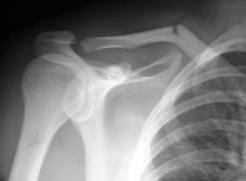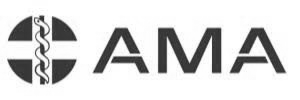Clavicle Fracture
What is a Clavicle Fracture
A Fractured Clavicle is also referred to as a Broken Collarbone. These fractures can be painful and can cause arm immobility.
The principal cause of a broken collarbone is trauma (sports injuries, car accidents, falls). Rare causes include diseases that weaken the collarbone such as osteoporosis or cancer.
Fractured Clavicles are the most commonly fractured bone in the body accounting for one in twenty adult bone fractures.
Types of Clavicle Fractures
Most fractures occur in the middle portion, or shaft, of the bone. Occasionally, the bone will break where it attaches at the ribcage or shoulder blade.
Clavicle Fractures can include:
- Slight Crack
- Break into many pieces (comminuted fracture).
- Broken Bones Aligned
- Broken Bones Aligned out of place (displaced fracture)
Most Clavicle Fractures can be treated by wearing a sling to keep the arm and shoulder from moving while the bone heals. Complex Clavicle Fractures, involving significant bone movement from a traumatic event may require surgery to realign the collarbone.
Symptoms of a Fractured Collarbone
Fractured Collarbone sufferers have the following symptoms:
- Pain
- Bruising, swelling, and tenderness over the collarbone
- Sagging shoulder (down and forward)
- Inability to lift the arm
- Grinding sensation when the arm is raised
- Deformity or "bump" over the break
How is a Clavicle Fractures Diagnosed
Patients who suspect they have AA require a fully diagnosis this can include:
Medical History
Your doctor will ask questions about:
- Current symptoms and what if any activities aggravate your condition, or how injury was sustained,
- Obtain a medical history including family or genetic links etc
- Determine any related former conditions diseases and treatments,
- Record health metrics (weight, mobility, blood pressure, heart rate, etc)
- Confirm medications, past and present
- Record habits, diet, exercise and other related actions
- Understand any risk factors or related complications or links
Physical Examination
Your doctor perform comprehensive physical evaluation that can include:
- Examining the affected area,
- Evaluate any swelling, pain, bruising or other features, etc
- Determine impact of condition such as range or motion, pain, diet, lifestyle,
- Record levels or severity of any symptoms
Diagnostic Testing
Once your doctor has completed the physical examination further tests maybe required. These tests can help your doctor determine or eliminate possible causes or impacts, or complete the diagnostic process and can include:
- Pathology - blood or other sample tests, lung functions, etc
- X-Ray -
- Ultrasound -
- Magnetic Resonance Imaging (MRI)
Once a final diagnosis has been completed your doctor can discuss with you and recommend any treatment options.
Non Surgical Treatment for Clavicle Fractures
Treatment for your condition can begin immediately and can include:
- Pain Medication - to treat pain or discomfort including nonsteroidal anti-inflammatory medications (NSAIDs) can relieve some
- Inflammation Medication - may be prescribed to alleviate swelling including antibiotics for infection control
- R.I.C.E. - To reduce the pain and swelling surrounding the injured area.
- Rest: Rest the affected area as more damage could result from putting pressure on the injury.
- Ice: Ice should be applied over a towel to the affected area
- Compression: Wrapping with an elastic bandage or an elasticated tubular bandage can help to minimize the swelling.
- Elevation: Elevating the injured area above heart level to help with any swelling and pain
- Sling - may be recommended
- Exercise - may be recommended
- Bracing - may be recommended to brace
- Taping - may be applied over the affected areas to reduce pain.
Surgical Treatment for Clavicle Fractures
In cases where either a conservative treatment has not resolved the problem or where a patient best or only treatment option is surgery, your doctor may recommend:
Surgery typically involves putting the broken pieces of bone back into position and preventing them from moving out of place until they are healed. This can improve shoulder strength when you have recovered.
Open Reduction & Internal Fixation - bone fragments are first repositioned (reduced) and aligned in place with hardware either:
- Metal plates and screws
- Pins and screws using smaller incisions
What if Clavicle Fractures go Untreated?
Where untreated the condition can change the Shoulders bone structure and become increasingly painful causing complications






